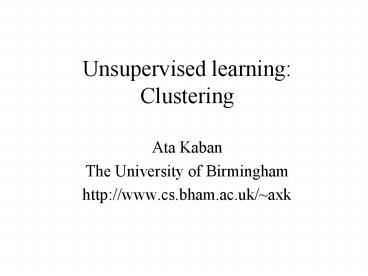Unsupervised learning: Clustering - PowerPoint PPT Presentation
1 / 24
Title:
Unsupervised learning: Clustering
Description:
Objective function that expresses our notion of interestingness for ... Define a measure of cluster compactness as the total distance from the cluster mean: ... – PowerPoint PPT presentation
Number of Views:28
Avg rating:3.0/5.0
Title: Unsupervised learning: Clustering
1
Unsupervised learning Clustering
- Ata Kaban
- The University of Birmingham
- http//www.cs.bham.ac.uk/axk
2
The Clustering Problem
Unsupervised Learning
Data (input)
Interesting structure (output)
- Should contain essential traits
- discard unessential details
- provide a compact summary the data
- interpretable for humans
Objective function that expresses our notion of
interestingness for this data
3
Here is some data
4
(No Transcript)
5
(No Transcript)
6
(No Transcript)
7
(No Transcript)
8
(No Transcript)
9
(No Transcript)
10
Formalising
- Data points xn n1,2, N
- Assume K clusters
- Binary indicator variables zkn associated with
each data point and cluster 1 if xn is in
cluster k and 0 otherwise - Define a measure of cluster compactness as the
total distance from the cluster mean
11
- Cluster quality objective (the smaller the
better) - Two sets of parameters - the cluster mean values
mk and the cluster allocation indicator variables
zkn - Minimise the above objective over each set of
variables while holding one set fixed ? This is
exactly what the K-means algorithm is doing! (can
you prove it?)
12
- Pseudo-code of K-means algorithm
- Begin
- initialize ?1, ?2, ,?K (randomly selected)
- do classify n samples according to nearest
?i - recompute ?i
- until no change in ?i
- return ?1, ?2, , ?K
- End
13
(No Transcript)
14
(No Transcript)
15
(No Transcript)
16
Other forms of clustering
- Many times, clusters are not disjoint, but a
cluster may have subclusters, in turn having
sub-subclusters. - ?Hierarchical clustering
17
- Given any two samples x and x, they will be
grouped together at some level, and if they are
grouped a level k, they remain grouped for all
higher levels - Hierarchical clustering ? tree representation
called dendrogram
18
- The similarity values may help to determine if
the grouping are natural or forced, but if they
are evenly distributed no information can be
gained - Another representation is based on set, e.g., on
the Venn diagrams
19
- Hierarchical clustering can be divided in
agglomerative and divisive. - Agglomerative (bottom up, clumping) start with n
singleton cluster and form the sequence by
merging clusters - Divisive (top down, splitting) start with all of
the samples in one cluster and form the sequence
by successively splitting clusters
20
- Agglomerative hierarchical clustering
- The procedure terminates when the specified
number of cluster has been obtained, and returns
the cluster as sets of points, rather than the
mean or a representative vector for each cluster
21
Application to image segmentation
22
Application to clustering face images
Cluster centres face prototypes
23
The problem of the number of clusters
- Typically, the number of clusters is known.
- When its not, that is a hard problem called
model selection. There are several ways of
proceed. - A common approach is to repeat the clustering
with K1, K2, K3, etc.
24
What did we learn today?
- Data clustering
- K-means algorithm in detail
- How K-means can get stuck and how to take care of
that - The outline of Hierarchical clustering methods































